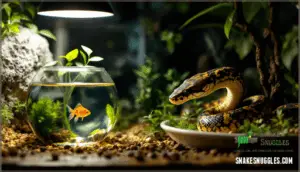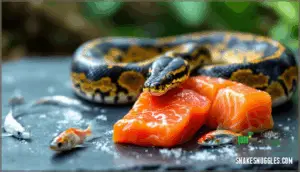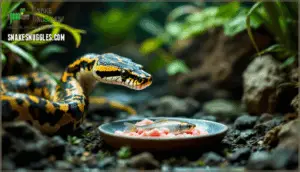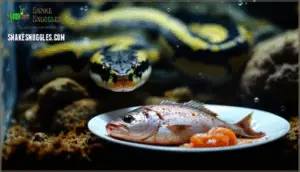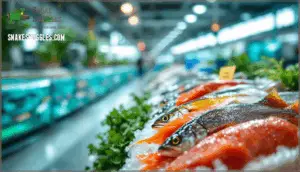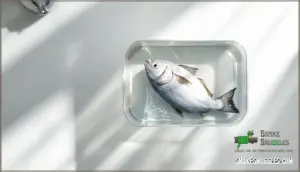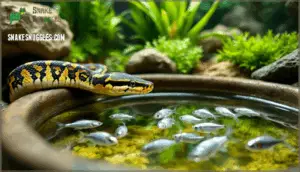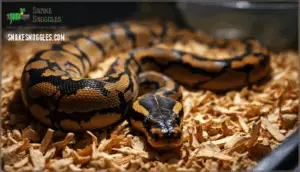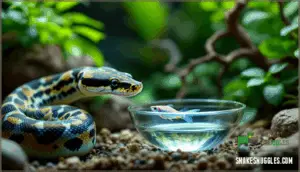This site is supported by our readers. We may earn a commission, at no cost to you, if you purchase through links.
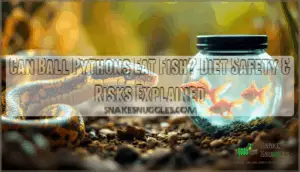
Fish can technically be offered as an occasional treat, but they come with serious risks that rodent-based diets don’t carry. Thiaminase enzymes in many fish species destroy vitamin B1, parasites lurk in improperly sourced seafood, and the nutritional profile simply doesn’t match what your python’s body expects.
Understanding when fish might be safe—and when they’re dangerous—protects your snake from deficiencies that won’t show up until real damage occurs.
Table Of Contents
- Key Takeaways
- Can Ball Pythons Eat Fish?
- What Nutrients Do Ball Pythons Need?
- Are Fish Safe for Ball Pythons?
- Which Fish Are Suitable for Ball Pythons?
- How Often Can Ball Pythons Eat Fish?
- Can Fish Be a Staple Food for Ball Pythons?
- What Are The Risks of Feeding Fish?
- How to Feed Fish to Ball Pythons Safely
- Signs of Nutritional Deficiency in Ball Pythons
- Should Fish Supplement a Ball Python’s Diet?
- Frequently Asked Questions (FAQs)
- Can ball pythons eat fish?
- How do you get a ball python to eat?
- Should you feed your ball python only one type of prey?
- Can ball pythons go without food?
- Can I feed my python fish?
- What else can ball pythons eat?
- Can pet snakes eat fish?
- Can my ball python eat raw chicken?
- How often do ball pythons eat rodents?
- What nutrients do rodents provide ball pythons?
- Conclusion
Key Takeaways
- Ball pythons can eat fish occasionally as a supplement, but fish shouldn’t replace rodents because they lack proper calcium ratios (1:15 instead of the ideal 2:1), contain thiaminase enzymes that destroy vitamin B1, and carry higher parasite risks than whole prey.
- Many fish species contain thiaminase, which breaks down thiamine (vitamin B1) in your snake’s digestive system and can lead to serious neurological problems like seizures, tremors, and poor coordination if fed regularly.
- If you do offer fish, stick with captive-bred freshwater species like guppies or minnows that are frozen-thawed to room temperature, limit feedings to once every 2-4 weeks, and never use saltwater fish due to dangerous sodium levels that strain your python’s kidneys.
- Rodents (mice and rats) should remain 70-80% of your ball python’s diet because they naturally provide the complete protein, calcium from bones, vitamin D3, and fatty acid profile that matches what these snakes evolved to digest in African grasslands.
Can Ball Pythons Eat Fish?
Ball pythons don’t naturally eat fish in the wild, but they can consume certain fish in captivity under specific conditions. Understanding what your snake normally eats helps you make safer choices about adding anything new to their diet.
Let’s look at how their natural feeding habits compare to what works in captivity.
Natural Diet of Ball Pythons
In the wild, ball pythons are opportunistic hunters that rely on rodents and birds as their primary prey items. Rodents—including mice, rats, and other small mammals—dominate their diet, making up roughly 70–80% of meals. Birds account for the remaining 20–30%, with juveniles and males showing higher bird consumption.
Dietary shifts occur as pythons mature, with habitat influence guiding prey selection toward what’s abundant and accessible. They’re also known to inhabit savanna and grasslands.
Occasional Fish Consumption in Captivity
While fish don’t show up on a ball python’s menu in the wild, some keepers in captivity offer them as an occasional alternative when their snakes refuse rodents or need dietary variety. Fish can work as a supplemental treat, though they come with caveats:
- Thiaminase concerns: Some fish contain enzymes that destroy vitamin B1
- Omega-3 fatty acids: Provide benefits but don’t replace rodent nutrition
- Fish preparation methods: Always thaw frozen fish completely to room temperature
- Fish meal size: Keep portions similar to your snake’s rodent prey
- Post-feeding observation: Watch for unusual conduct after introducing fish to your ball python diet
Differences Between Wild and Captive Diets
Your ball python’s experience in a terrarium differs dramatically from what it would encounter prowling through African grasslands at night. In wild habitats, prey availability changes seasonally, forcing dietary adaptations your captive snake never faces.
Wild ball pythons hunt diverse prey animals—birds, rodents, and small mammals—creating nutritional variance that affects their gut microbiome differently than the frozen rodents you offer. These differences carry health implications worth understanding when considering alternative food sources for your ball python diet.
What Nutrients Do Ball Pythons Need?
Your ball python’s body runs on specific building blocks to stay healthy and strong. Understanding what nutrients they need helps you make smart choices about their meals, whether you’re considering rodents, birds, or the occasional fish.
Let’s look at the three key nutritional areas that keep your snake thriving.
Protein and Calcium Requirements
Think of your ball python as a finely tuned machine that runs on specific fuel. Protein and calcium are the two essential nutrients that power growth, muscle development, and strong bones in these snakes. Whole prey items like rodents deliver about 50-60% protein by dry matter, which your snake uses as its main energy source right after eating. Calcium, mostly stored in bones, keeps their skeleton healthy, with ideal levels around 47 grams per kilogram of body weight.
Here’s what you need to know about the nutritional needs of ball pythons:
- Dietary protein from whole rodents sustains continuous growth and tissue repair throughout their 30-year lifespan
- Calcium sources matter—whole prey with bones provides far more calcium than boneless fish or incomplete meals
- Bone health depends on a 2:1 calcium-to-phosphorus ratio, which rodents naturally provide but fish often lack
- Prey composition directly affects nutrient absorption—muscle and bone together deliver balanced nutrition
- Nutritional deficiencies from poor calcium or protein intake lead to stunted growth, metabolic bone disease, and skeletal deformities
Fish simply can’t match what rodents offer for meeting these core requirements. A balanced diet requires whole prey animals to make certain of complete nutrition.
Importance of Vitamin D3 and Fatty Acids
Without vitamin D3 and the right blend of fatty acids, even a well-fed ball python can suffer serious health problems that won’t show up until it’s too late. Vitamin D3 helps your snake absorb calcium properly, preventing Metabolic Bone Disease and skeletal deformities. Essential fatty acids support healthy skin, smooth shedding, and immune function.
Rodents naturally provide balanced nutrition with adequate D3 sources and fatty acid benefits, while fish supplementation benefits remain limited and can actually worsen nutritional deficiencies if overused.
Role of Balanced Prey Variety
Variety in your ball python’s menu isn’t just about keeping things interesting—it’s the foundation of long-term health and vitality. Mimicking nature through prey rotation makes certain your snake receives varied nutrition for peak health:
- Rodents provide essential protein and calcium ball pythons need
- Birds offer different fatty acid profiles than mammals alone
- Dietary diversity prevents nutritional gaps in captive diets
- Balanced prey items support immune function and strong growth
- Rotating between rats, mice, and birds creates a truly complete diet
Are Fish Safe for Ball Pythons?
Fish might seem like an easy meal option for your ball python, but safety concerns deserve careful attention. Feeding fish introduces risks that don’t exist with traditional rodent prey.
Let’s examine three main concerns you should understand before offering fish to your snake.
Parasite and Bacterial Risks
Fish-borne parasites pose real health risks to your ball python. Up to 59% of wild-caught fish carry trematodes, nematodes, or other internal parasites that can infect your snake’s lungs and intestines. Bacterial contamination from Aeromonas and Pseudomonas species can trigger septicemia, mouth rot, and tissue necrosis. There’s also zoonotic potential—Salmonella appears in up to 60% of reptile enclosures and can cause gastrointestinal infection in humans, especially children and immunocompromised individuals.
| Risk Factor | Impact on Ball Pythons |
|---|---|
| Parasite Transmission | Lungworms, intestinal helminths, respiratory compromise |
| Bacterial Contamination | Septicemia, scale rot, lethargy, tissue damage |
| Seasonal Factors | Higher parasite loads in summer/autumn fish |
Freezing fish before feeding reduces parasite transmission by roughly 80% compared to live fish. Frozen-thawed options remain safer, though they don’t eliminate all health risks.
Thiaminase and Vitamin B1 Deficiency
Certain fish species contain thiaminase, an enzyme that breaks down vitamin B1 in your snake’s body, and repeated feedings can quietly starve your ball python of this essential nutrient.
Over weeks or months, B1 absorption drops, triggering neurological effects like muscle tremors, poor coordination, and seizures. Deficiency symptoms include lethargy, appetite loss, and abnormal posturing.
The long-term impact can be fatal without intervention, making rodents and birds far safer choices for your ball python.
Sodium Content in Saltwater Fish
Saltwater fish pack far more sodium than your ball python’s kidneys are built to process, and even a single feeding can strain its delicate water balance. Excessive sodium triggers dehydration risks and osmoregulation issues, forcing your snake’s body to work overtime removing salt.
Kidney strain from repeated saltwater fish feedings can lead to long-term organ damage. Stick with freshwater options like guppies to protect your ball python’s health.
Which Fish Are Suitable for Ball Pythons?
If you’re thinking about offering fish, you’ll want to choose the right kind. Not all fish are safe for your ball python, and some can cause serious health problems.
Let’s look at which species work best, which ones to skip, and whether frozen or live is important.
Recommended Species (e.g., Guppies, Minnows)
When you’re choosing safe fish options, guppies and rosy red minnows top the list. Guppies (Poecilia reticulata) offer excellent guppy nutritional value with low thiaminase content, making them a smart choice for occasional enrichment. Minnows boast a solid minnow safety profile, while mollies, platies, and swordtails provide alternative fish options.
Captive-bred benefits include minimal species parasite risk compared to wild-caught varieties. Always use frozen-thawed fish from your types of fish for ball pythons selection to improve your snake’s fish diet safely.
Fish to Avoid (e.g., Salmon, Wild-Caught)
While guppies and minnows offer a safer choice, not all fish belong on your ball python’s menu, and some popular options can actually put your snake at serious risk. Here’s what to avoid:
- Fatty fish like salmon, mackerel, and trout contain excessive oils that disrupt digestion and provide poor nutritional balance
- Saltwater fish introduce dangerous sodium levels, causing dehydration and kidney strain
- Wild-caught fish carry higher parasite loads and thiaminase risk, leading to fatal vitamin B1 deficiency
Skip these health concerns by sticking with captive-bred, freshwater options for your snake’s fish diet.
Frozen-Thawed Vs. Live Fish
Once you’ve picked the right fish, the next question is whether to serve them frozen-thawed or wiggling and alive. Frozen-thawed fish offer clear advantages: thawing eliminates many parasites, reduces live fish risks like injury from bites, and resolves ethical considerations.
However, a nutritional comparison shows both options work when sourced properly. Thawing benefits outweigh treatment differences, making frozen foods the safer choice for parasite transmission prevention.
How Often Can Ball Pythons Eat Fish?
Fish shouldn’t be a regular part of your ball python’s menu, but you might wonder how often it’s okay to offer them. Getting the timing and portion sizes right matters for your snake’s health.
Here’s what you need to know about frequency, preparation, and keeping an eye on how your python responds.
Appropriate Feeding Frequency
If you’re thinking about adding fish to your ball python’s menu, limit it to once every two to four weeks at most. This feeding frequency helps prevent nutritional imbalances while your snake continues getting proper rodent-based meals.
Consider these factors when planning fish feedings:
- Age-based schedules affect overall feeding intervals
- Individual variation means some ball pythons tolerate fish better than others
- Obesity prevention requires monitoring body condition
- Breeding considerations may demand adjusting diet composition
Always prioritize rodents as the primary food source.
Portion Size and Meal Preparation
When offering fish to your ball python, stick to prey items roughly the same diameter as the thickest part of the snake’s body. Remember that proper thawing makes all the difference. Fish should be completely thawed and reach room temperature before feeding—cold meals can cause digestive issues or refusal to eat.
| Preparation Step | Details |
|---|---|
| Thawing fish | Place frozen fish in refrigerator overnight, then warm to room temp |
| Prey size | Match thickness of snake’s widest body section |
| Safe practices | Use tongs when offering live fish to prevent injury |
Monitoring Snake’s Health and Appetite
After you introduce fish to your ball python’s routine, keep a close watch on how your snake reacts to these meals over the following weeks.
Track these key health indicators:
- Appetite Changes – Note any refusal or reluctance to feed
- Weight Monitoring – Weigh your snake monthly to catch gradual loss
- Shedding Patterns – Watch for incomplete or difficult sheds
- Fecal Examination – Check droppings for abnormal appearance or parasites
Observation of conduct helps catch digestive issues early, and any health concerns warrant a veterinary visit.
Can Fish Be a Staple Food for Ball Pythons?
You might wonder if fish can become your ball python’s go-to meal instead of just an occasional treat. The short answer is no, and the reasons come down to nutrition, health risks, and what these snakes actually need to thrive.
Let’s look at why rodents and birds should remain the foundation of your python’s diet.
Nutritional Limitations of Fish
Fish fall short nutritionally because they lack key vitamins and minerals your ball python needs. Vitamin deficiencies arise quickly—fish provide minimal vitamin D and E compared to rodents. The calcium imbalance is striking: fish deliver a 1:15 calcium-to-phosphorus ratio instead of the ideal 2:1. Thiaminase presence in many species causes thiamine deficiency in snakes, leading to neurological problems. Their macronutrient profile is weaker too, with less protein and missing essential fatty acids. Digestive issues can emerge from fish’s high water content and soft tissue, which reduce gut stimulation.
| Nutritional Factor | Fish | Rodents |
|---|---|---|
| Calcium-to-Phosphorus Ratio | 1:15 | 2:1 |
| Protein Content | 18–22% | 25–30% |
| Vitamin D3 | Insufficient | Adequate |
| Thiaminase Risk | Present in many species | Absent |
Risks of Solely Feeding Fish
Feeding only fish to your ball python creates a chain reaction of health problems that can shorten its life. This imbalanced diet triggers serious complications:
- Vitamin deficiency weakens immunity and bone structure
- Thiamine deficiency in snakes causes seizures and neurological damage
- Organ strain from processing excess sodium and low-quality protein
- Growth problems emerge as nutritional deficiencies accumulate
Parasites and digestive issues compound these long-term effects, making fish-only diets dangerous.
Importance of Rodents and Birds
Rodents and birds aren’t just alternatives to fish—they’re the nutritional foundation your ball python evolved to thrive on. Wild prey variety includes rat pups and day-old chicks, which deliver the protein, calcium, and fat ratios your snake needs.
Captive diet needs mirror this pattern—rodents as primary food with occasional bird prey items maintain nutritional balance. This bird/rodent ratio promotes healthy growth because rodent availability in captivity makes them ideal staples.
What Are The Risks of Feeding Fish?
While fish might seem like a harmless alternative, they bring some serious risks to the table. From missing nutrients to unwanted parasites, there’s more to worry about than you’d think.
Let’s break down the three main concerns you should know before offering fish to your ball python.
Nutritional Deficiencies
Your snake’s body wasn’t built to thrive on fish alone. While rodents deliver balanced nutrition, fish diets often fall short in critical ways:
- Thiamine deficiency in snakes from fish containing thiaminase can trigger seizures and neurological damage
- Calcium concerns arise when fish’s inverted calcium-to-phosphorus ratio weakens bones over time
- Protein mismatch occurs as fish lack the complete amino acid profile your python needs for healthy growth
- Vitamin imbalances develop without adequate D3, leading to poor calcium absorption and metabolic bone disease
These nutritional deficiencies in snakes don’t appear overnight—malnutrition builds gradually until serious symptoms emerge.
Parasite Transmission
Every fish you offer comes with uninvited guests—parasites lurking invisibly beneath the scales. Wild-caught fish carry higher risks than captive-bred options, hosting roundworms, tapeworms, and flukes that transfer directly to your python.
These parasites in fish establish themselves in your snake’s digestive tract, causing weight loss and compromised immunity.
Prevention methods include sourcing quality frozen fish from reputable suppliers and avoiding wild-caught specimens entirely.
Digestive and Health Concerns
Beyond the immediate threat of parasites, fish can wreak havoc on your ball python’s entire digestive system in ways you mightn’t expect. Your snake’s digestive enzymes evolved to break down mammals and birds, not aquatic prey.
Fish disrupt the gut microbiome, causing digestive issues that lead to regurgitation and bloating. Over time, improper meals strain key organs, while nutritional deficiencies—especially vitamin deficiencies—compound into serious long-term effects on your python’s overall health.
How to Feed Fish to Ball Pythons Safely
If you decide to offer fish, taking a few safety steps can help protect your ball python’s health. Proper sourcing, temperature control, and careful management make a real difference in preventing illness or injury.
Here’s what you need to know about feeding fish safely.
Sourcing Disease-Free Fish
When you’re ready to offer fish to your ball python, choosing the right source can mean the difference between a healthy treat and a potential health crisis. Fish farms with disease testing and fish certification provide the safest options, reducing parasite transmission risks.
Inspect each fish carefully for visible abnormalities before offering. Freshwater species from reputable suppliers usually have better nutritional value and fewer digestive issues than wild-caught alternatives, while maintaining beneficial omega-3 fatty acids your snake needs.
Proper Thawing and Temperature
Once you’ve got the right fish, thawing it correctly protects your snake from temperature shock and digestion problems. Place frozen-thawed prey in a sealed bag, then submerge it in room-temperature water for gradual thawing. Never use hot water—it degrades nutritional value and omega-3 fatty acids.
Before offering, check that the fish reaches room temperature throughout, which aids proper thermal regulation and helps your python digest its meal without stress.
Handling Live Fish
Live fish bring a whole new challenge—your python might get injured by sharp fins or hooks, and stressed fish dart around in ways that can confuse even an experienced hunter. To protect your snake and minimize parasite transmission risks, follow these live fish safety steps:
- Use feeder-grade fish only—never wild-caught species that harbor unknown parasites
- Supervise every feeding session to prevent fin injuries or escape
- Remove uneaten fish immediately to avoid water quality issues and stress
Frozen-thawed fish remain the safer choice for feeding ball pythons fish.
Signs of Nutritional Deficiency in Ball Pythons
When your ball python isn’t getting the right nutrients, its body will send warning signals you need to watch for. These signs can show up in how it looks, acts, and grows.
Let’s look at the key symptoms that suggest your snake might be missing important vitamins or minerals.
Poor Growth and Lethargy
If your ball python seems sluggish or isn’t growing the way it should, a poor diet might be stealing the nutrients it needs to thrive. Malnutrition effects from dietary imbalances can slow growth rates and trigger lethargy, such as insufficient omega-3 fatty acids or protein. Without proper nutritional value, your snake faces health decline, including metabolic bone disease, digestive problems, and vulnerability to internal parasites.
| Deficiency Sign | Possible Cause |
|---|---|
| Stunted growth | Inadequate protein or calcium intake |
| Persistent lethargy | Low energy from poor nutritional value |
| Weight loss | Digestive problems or internal parasites |
| Weak muscle tone | Insufficient omega-3 fatty acids |
| Dull appearance | Dietary imbalances affecting overall health |
Bone and Shedding Problems
A lack of calcium and other essential minerals can leave your snake’s bones brittle and its skin struggling to peel away cleanly during a shed. You might notice skeletal problems like soft jaw bones or kinked spines—classic signs of metabolic bone disease. Shedding issues such as retained patches or incomplete molts often point to calcium deficiency or digestive problems affecting nutritional value.
- Metabolic bone disease weakens bone health, causing deformities
- Retained shed indicates poor hydration or skin disorders
- Softened bones make your snake fragile and prone to fractures
- Incomplete shedding signals underlying calcium or vitamin imbalances
Behavioral Changes
Subtle shifts in how your snake behaves—refusing meals, hiding more often, or seeming unusually sluggish—can reveal nutritional gaps long before physical symptoms appear. A hunger strike might signal digestive issues in snakes rather than simple pickiness.
Watch for stress signals like defensive posturing or changes in snake temperament, which often point to declining wellbeing. Environmental enrichment and observing feeding cues help you catch problems early and protect your ball python’s health.
Should Fish Supplement a Ball Python’s Diet?
After weighing the pros and cons, you might wonder if fish have a place in your ball python’s menu at all. The answer isn’t a simple yes or no, and it depends on how you approach it.
Let’s look at when fish might work as an occasional addition, how to keep the diet balanced, and why expert guidance matters.
Benefits of Occasional Fish Treats
Offering fish every few weeks can add variety to your ball python’s diet, which may encourage reluctant eaters to show more interest in their meals. Fish provide dietary enrichment that engages different feeding instincts, potentially stimulating snakes with picky preferences.
Some benefits of occasional fish treats include:
- Omega-3 fatty acids from fish like tilapia support healthy skin and organ function
- Feeding diversity helps prevent meal fatigue in captive ball pythons
- Fish nutrition offers a different protein source, though it doesn’t meet all nutritional needs of ball pythons
This treat variety keeps your snake engaged without replacing its essential rodent-based diet.
Balancing Fish With Rodents and Birds
Your ball python thrives on a well-rounded feeding plan that includes rodents as the main course, with birds and fish serving as occasional supporting players. This meal planning approach guarantees your snake receives proper nutrition balance while dietary variety keeps feeding interesting.
| Prey Item | Feeding Frequency |
|---|---|
| Rodents (mice/rats) | Every 7-14 days |
| Birds (chicks/quail) | Every 3-4 weeks |
| Fish (guppies/minnows) | Every 2-4 weeks |
Effective feeding strategies rotate these prey items thoughtfully, preventing nutritional deficiencies that occur when ball pythons eat only one food type.
Consulting Reptile Veterinarians
Reptile experts with specialized training in snake health become your most reliable partners when planning dietary changes for ball pythons. Veterinary care guarantees you’re making evidence-based decisions about feeding fish or other non-standard prey items.
- Schedule annual health consultations with a qualified reptile veterinarian to monitor your snake’s nutritional status and growth
- Request blood panels checking calcium, phosphorus, and vitamin D3 levels before introducing fish into your ball python’s diet planning
- Seek professional guidance if you notice signs like poor shedding, swelling, or appetite changes in your carnivorous snakes
- Ask your reptile veterinarian about appropriate feeding intervals and prey sizing specific to your snake’s age and condition
- Get immediate assessment if digestive issues arise after feeding fish, as prompt intervention prevents serious complications
Professional oversight reduces diet-related health problems in captive snakes by over 70 percent.
Frequently Asked Questions (FAQs)
Can ball pythons eat fish?
Yes, ball pythons can eat fish, but think of it like offering dessert instead of dinner—it works occasionally, not regularly.
Fish lack the complete nutritional value rodents provide and pose health concerns like parasites and vitamin deficiencies. Fish preparation methods matter greatly for safety.
How do you get a ball python to eat?
Environmental factors like heating concerns and stress reduction matter most when ball pythons refuse prey items.
Scenting prey with chicken broth helps during hunger strikes. Try offering different rodents before managing refusal as a diet issue requiring supplemental treats.
Should you feed your ball python only one type of prey?
Feeding only one prey type risks nutritional gaps. Wild Diet Mimicry through Prey Variety Promotes Nutritional Completeness—ball pythons thrive when their diet includes diverse prey items like rodents and birds, supporting Long-Term Effects for Healthier Snakes.
Can ball pythons go without food?
Ball pythons can fast for extended periods—adults may refuse food for weeks or months, especially during brumation or breeding season. Hunger strikes often stem from stress, improper temperatures, or shedding cycles.
Monitor health closely and adjust feeding frequency guidelines. Re-feeding tips include optimizing enclosure conditions.
Can I feed my python fish?
You can offer fish occasionally, but they shouldn’t replace rodents in your ball python’s diet.
Fish carry parasite risks and lack key nutrients that prey items like rats provide.
Stick to small, freshwater species like guppies, and limit fish feeding frequency to every few weeks.
What else can ball pythons eat?
Rodents like mice and rats form the foundation of your ball python’s diet, but small birds such as quail chicks add variety.
Other reptiles, amphibians, eggs, and insects aren’t appropriate prey items for these specialized feeders.
Can pet snakes eat fish?
It depends on the species. Some snakes naturally eat fish as part of their diet, while ball pythons don’t.
Fishy snake diet works for water snakes and garter snakes, but nutritional fish value differs from prey items like rodents, creating potential health risks.
Can my ball python eat raw chicken?
Don’t feed your ball python raw chicken—it’s practically inviting health concerns into your terrarium. Raw chicken risks Salmonella exposure and lacks the nutritional value of whole prey.
Unlike rodents, raw meats don’t provide essential calcium or proper protein ratios for ball pythons’ diet and health.
How often do ball pythons eat rodents?
Adult ball pythons usually eat rodents every 3 to 6 weeks, while younger snakes need prey items more frequently.
Age-based needs, size-based needs, and activity level all influence this individual variation in snake feeding schedules.
What nutrients do rodents provide ball pythons?
Think of rodents as nature’s perfectly wrapped nutritional packages for your python. Mice and rats deliver complete protein with essential amino acids, balanced calcium-phosphorus ratios, beneficial fats, and key organ nutrients that support strong bones, healthy growth, and overall wellness.
Conclusion
Think of your python’s diet like building a house—rodents are the foundation, and fish are decorative trim. While ball pythons can eat fish occasionally without disaster, they can’t replace the nutritional bedrock your snake evolved to need.
Thiaminase, parasites, and missing nutrients make fish risky unless you’re treating them as rare supplements, not staples. Stick with mice and rats as your go-to meals, and your python will thrive on what its body naturally expects.
- https://bewildnc.org/diversifying-snake-diets/
- https://reptilesmagazine.com/ball-python-diet-and-feeding/
- https://exoticpetvetblog.wordpress.com/2015/02/17/thiamine-vitamin-b1-deficiency-in-garter-snakes/
- https://www.aussiepythons.com/threads/feeding-pythons-fish.40491/
- https://journals.biologists.com/jeb/article/218/13/2089/13810/Digesting-pythons-quickly-oxidize-the-proteins-in


